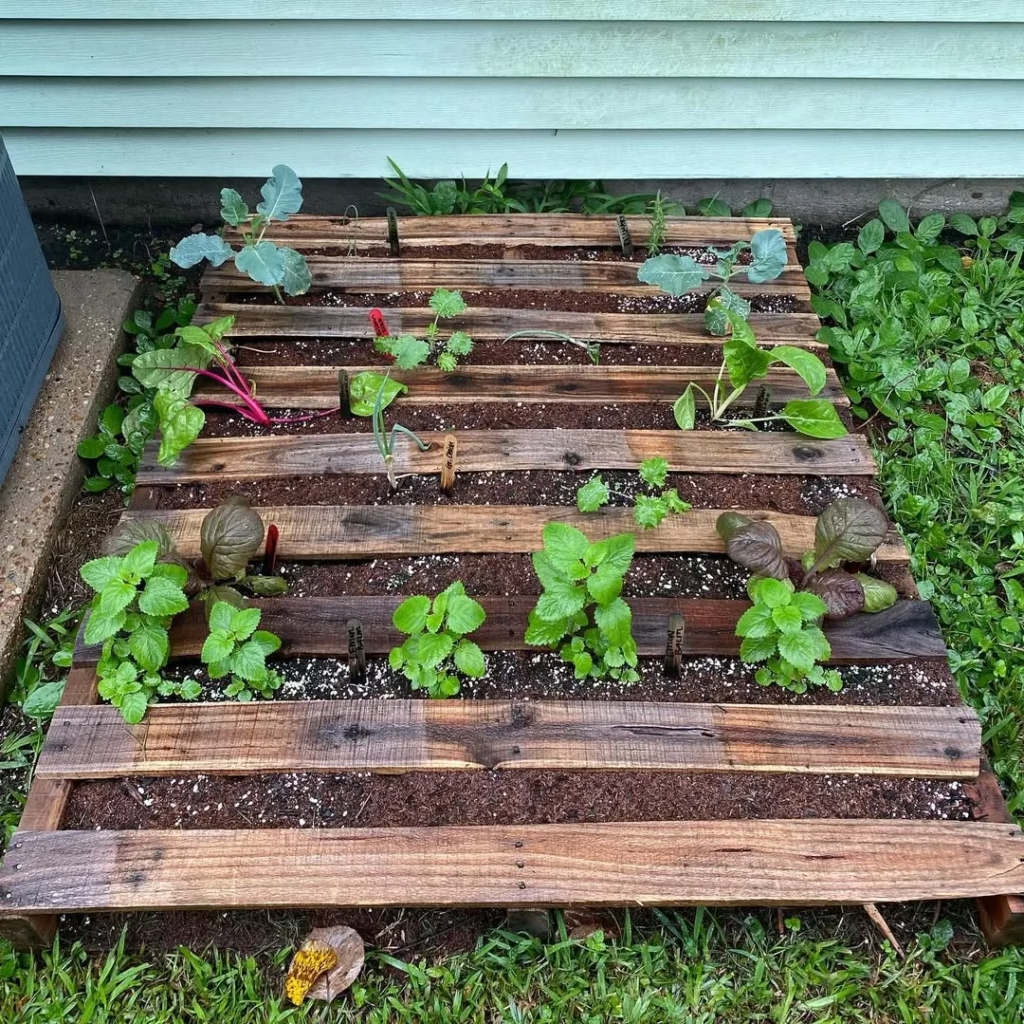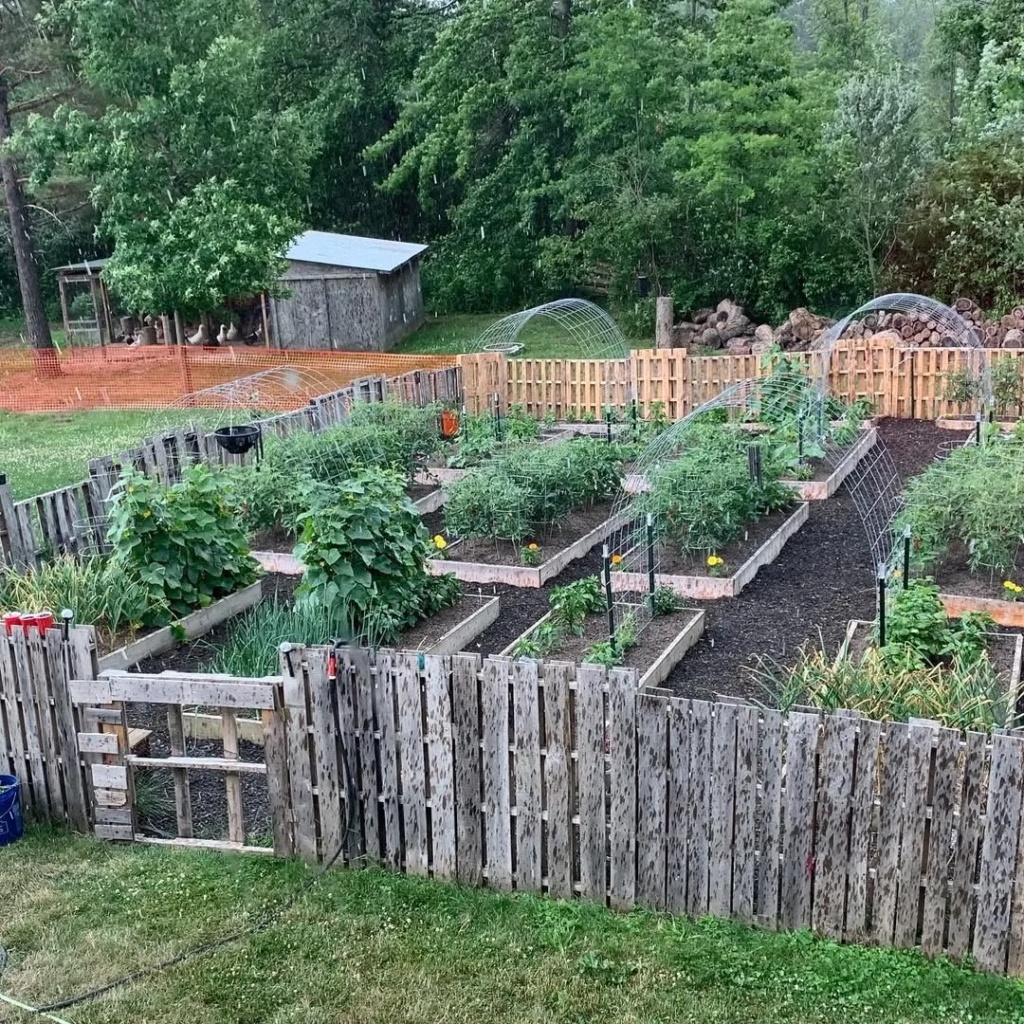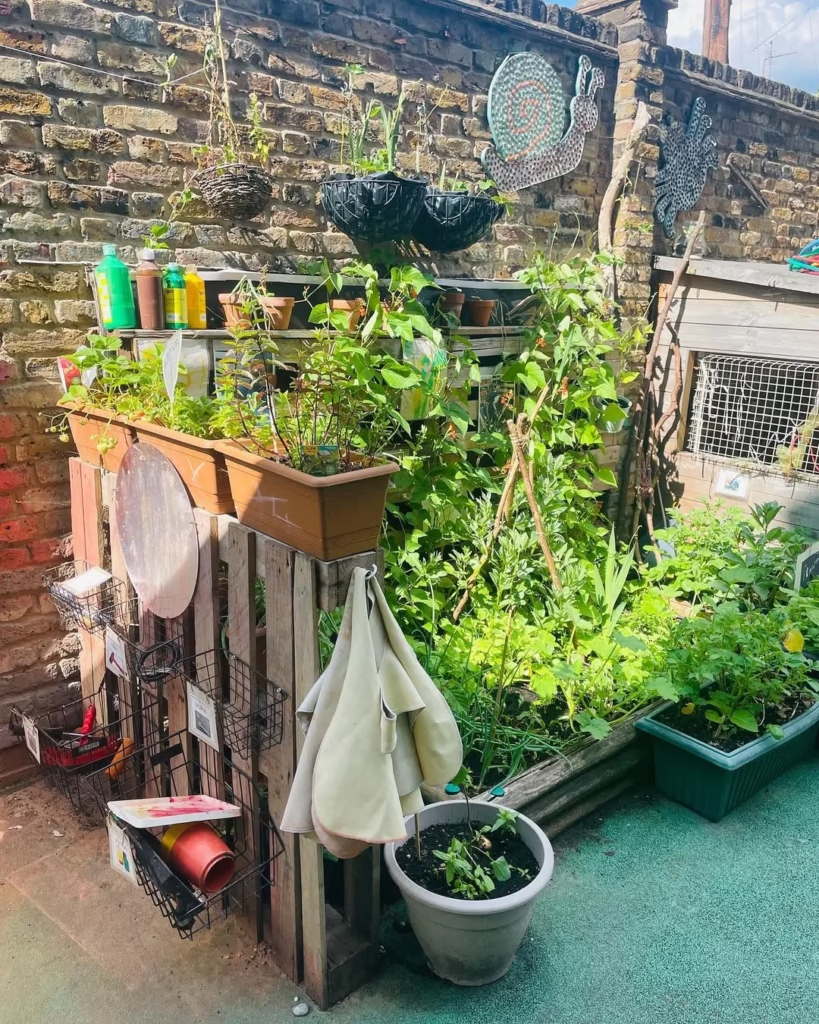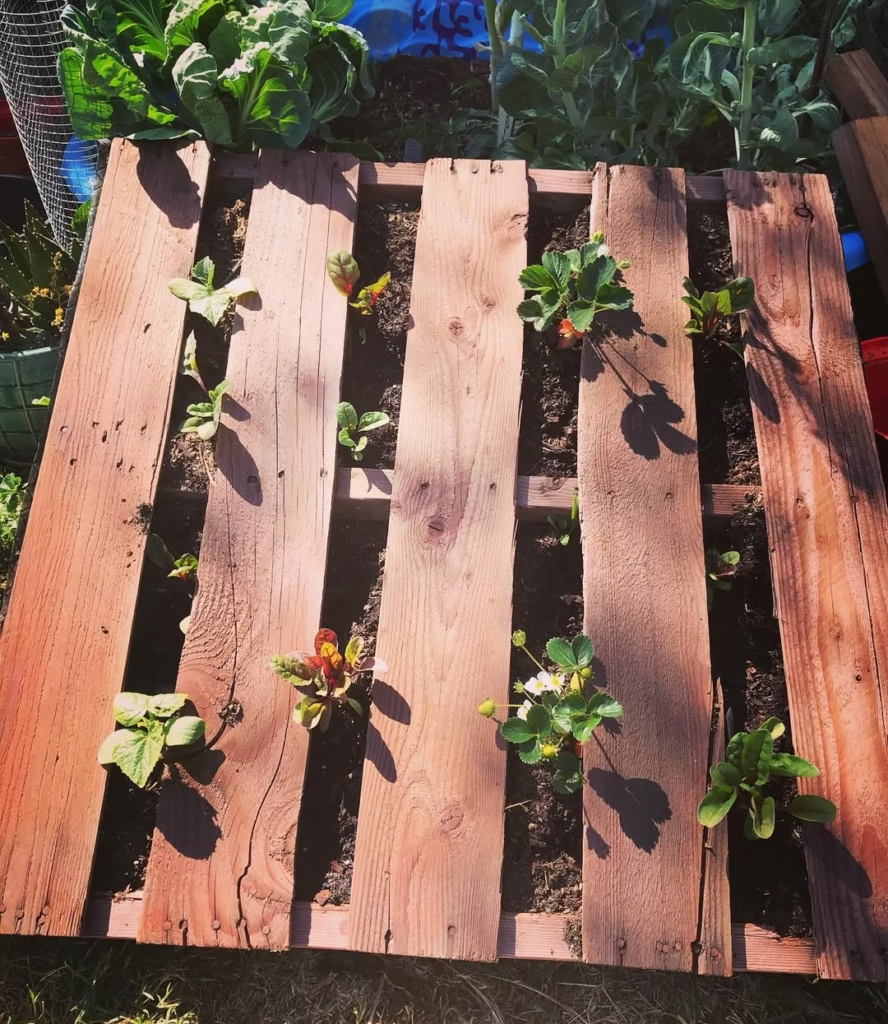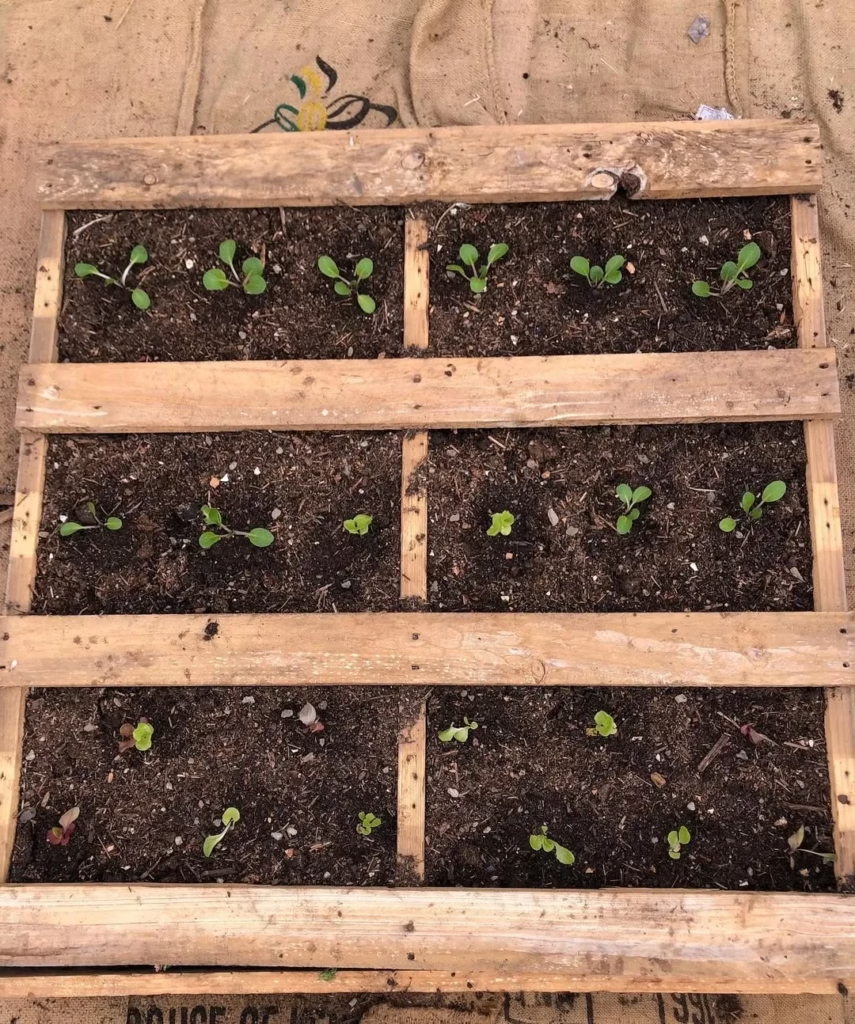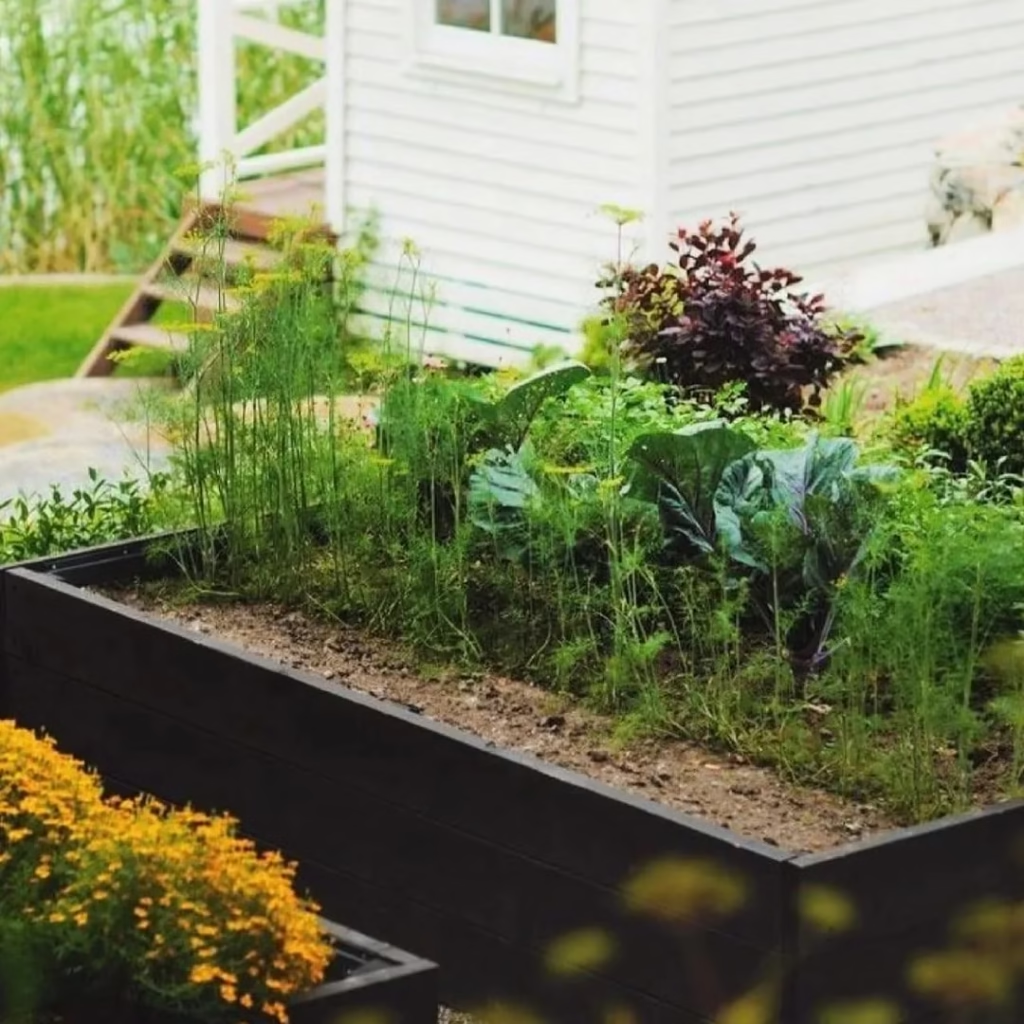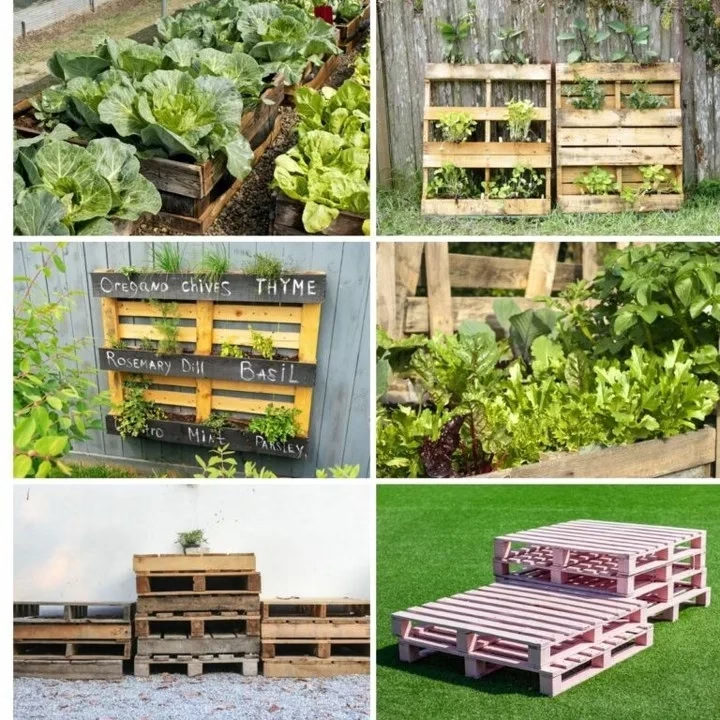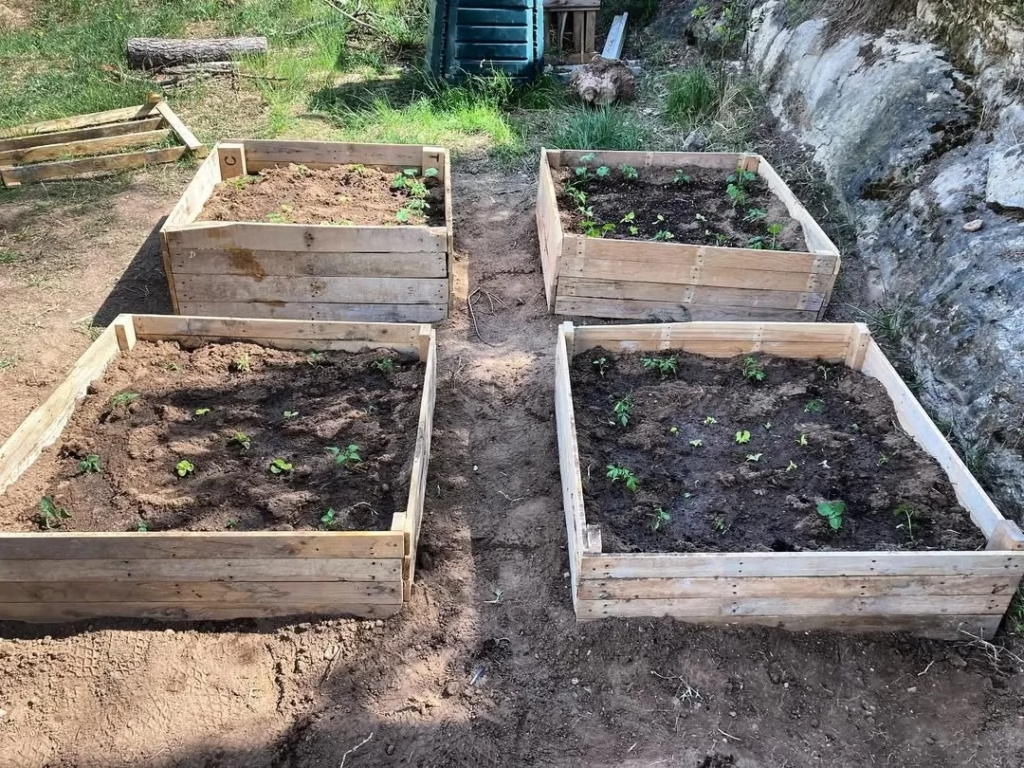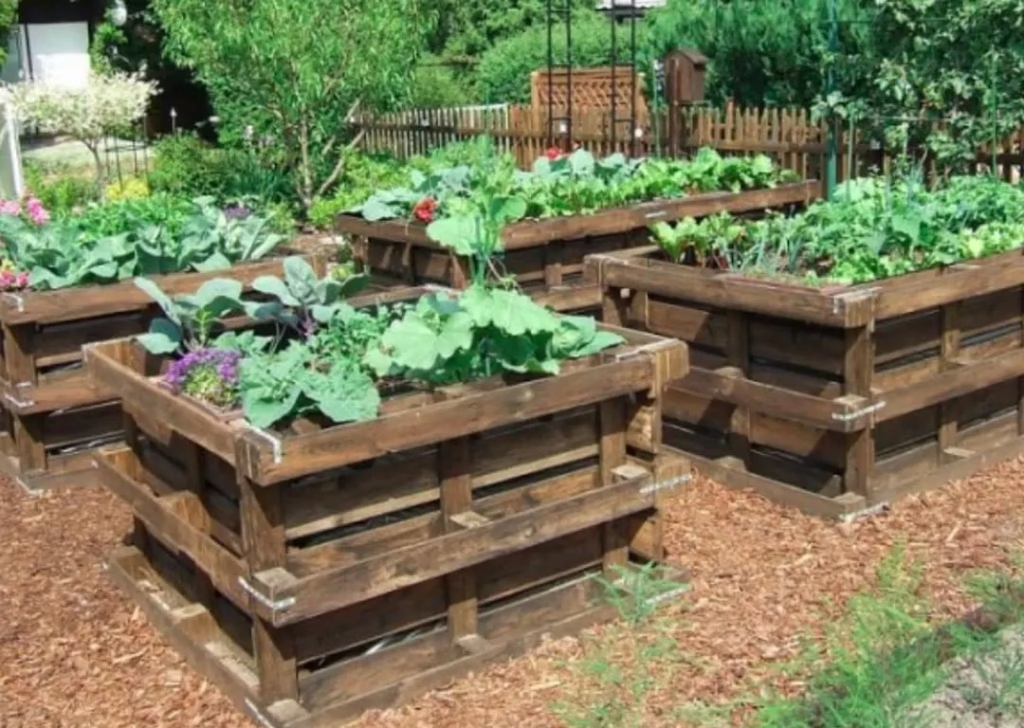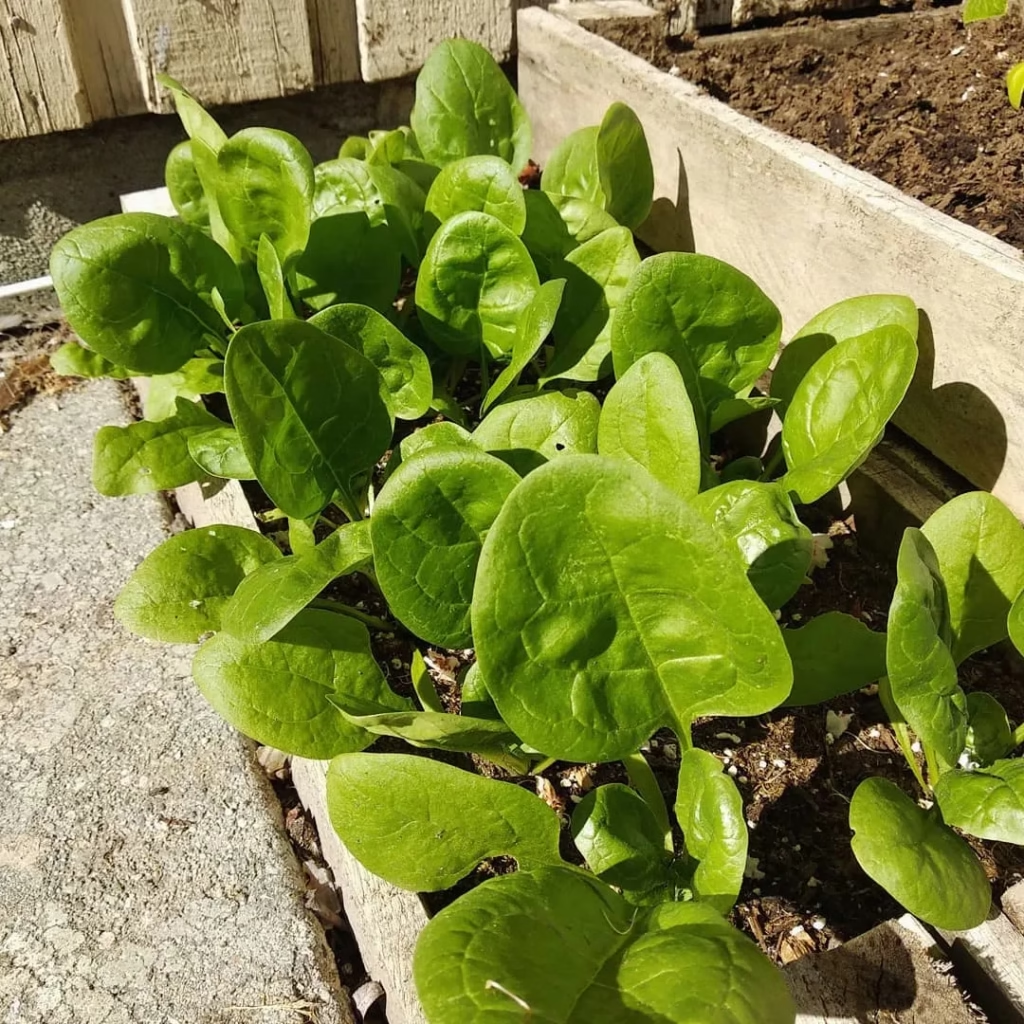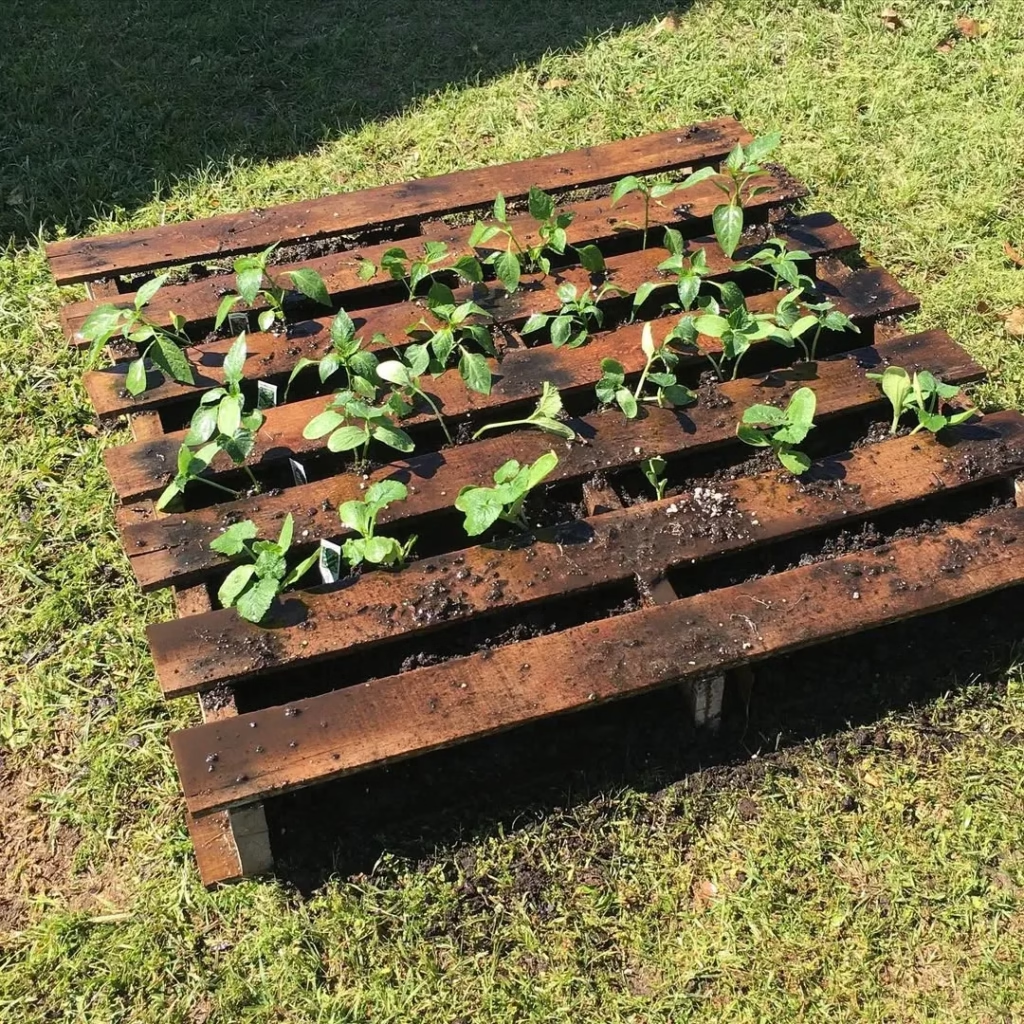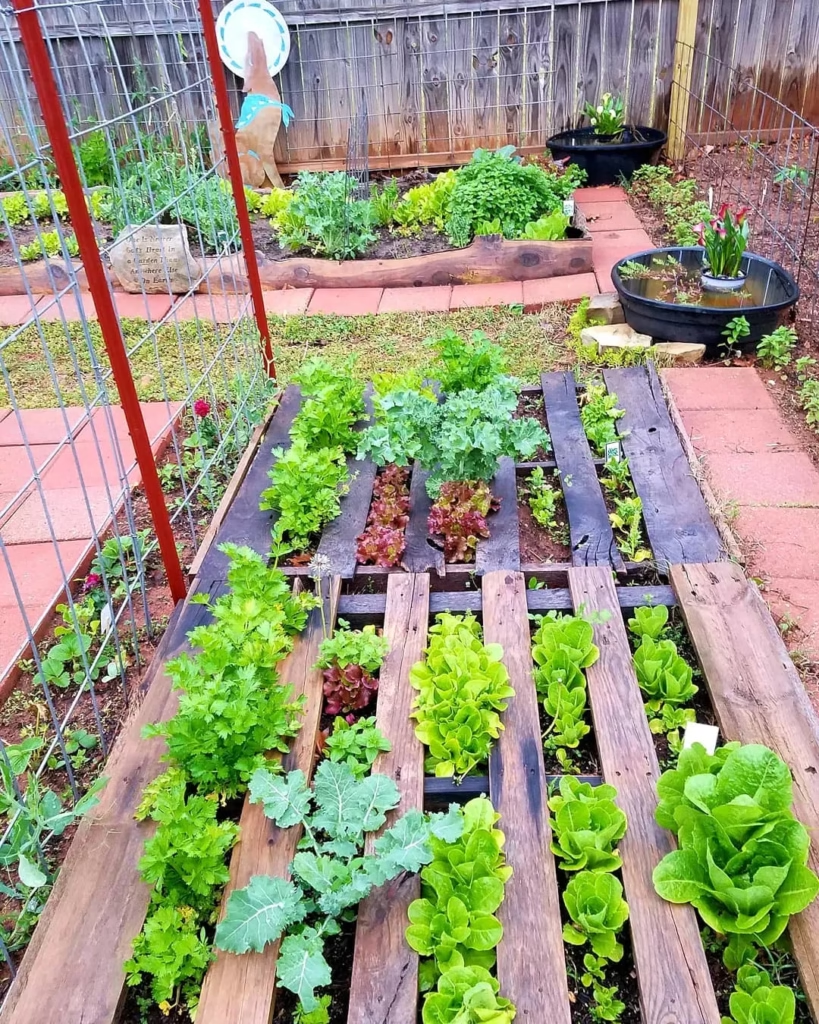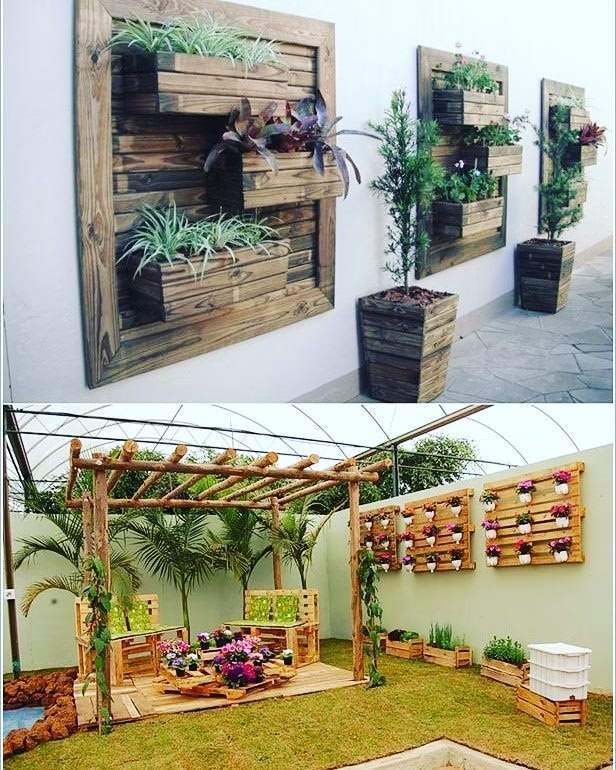Gardening} Pallet Garden Borders | 11 Beautiful Pallet Garden Borders Pallet are low-costbut can be used literately so here you can channel your creativity in gardening. First, scrounge up some old wooden pallets — many businesses will give them to you, or you can pick them up for free online. Now that you have your pallets, the first thing you need to do is take them apart, making sure not to damage the wood in the process. Pry up your border planks with a pry bar or hammer. Then, think about the design you would like to create. Pallet garden borders can be as easy or complicated as you want, depending on your style. Roughly the simplest approach is to just lay the planks side by side in a row, or to lay them in the shape of a rectangular frame around your garden beds. To make it more decorative, you can curved your border, or stack pallets with each other to create height and dimension. Once your design is assembled, you need to treat the wood so it will withstand the elements. To ensure the pallets do not degrade over time, a non-toxic wood sealant will help protect against moisture and other pests. When your border is complete, fill your garden beds with soil and plants, and let the rustic look of the pallets set off your greenery. This DIY planter will help you define your planting spaces, while adding an unconventional accent to your garden. Be the crafty one and revel in creating beautiful and eco-friendly pallet garden borders that will enhance your outdoor space!
Fruit Pallet Garden Border
This line emphasizes the benefits of creating a fruit pallet garden border, and the following lines encourage readers to try it in their own backyards. Milk crates on vintage paver bricks will look amazing and serve as a great foundation for growing shade plants, while wooden pallets create beautiful borders in your garden. Start by sourcing a few quality pallets, preferably untreated and in good condition. Disassemble the pallets making sure to keep the wood intact for your project. If you have your planks pale, design your border to coordinate with your fruit garden layout. A simple straight edge or design curves to follow the shape of your garden. Q: We want to use timber (connecting pieces as needed) or stacked pallets to create Garden BlocksTalk me through some ideas in a way that is interactive, and can also provide height, as a visual element that helps define the space for your fruit plantsStample Message. Once you create your border, you may also want to seal the wood with a non-toxic sealant to protect it from pest and moisture damage. By doing this step you will help your pallets to last longer and look colorful for the seasons. After the border is set up, provide your planting space with rich soil and choose different fruit plants like strawberries, raspberries, or miniature fruits to grow as per the space you have defined. Thus, with your fruit garden going, the pallet border will serve not just as a physical boundary but also as an aesthetic addition to your outdoor space. Have fun doing it, and take pleasure in enjoying homegrown fruit — all in the beautiful creative use of pallets in your gardening! 10 Garden on a Pallet
Guerrilla Gardening Pallet
Pallet gardening is an innovative and sustainable approach to beautifying neglected urban areas and promoting community involvement. Direct gardening means planting flowers, vegetables, and herbs in areas that might otherwise remain untended to, and it is done using resourced materials like wooden pallets that they can repurpose for beautiful displays. For your first project, collect wooden pallets from the local businesses or construction sites. And once you have some pallets, consider how to make the best use of them. They can be turned into vertical gardens, enabling you to plant a wide range of plants in confined areas. Plant these vertically by stacking up some pallets in standing position to the wall or fence and filling them with potting soil as seen in the video, they will turn out to be a very eye-catching and inspiring sight for the community. Before it comes time to plant, think about what kind of plants will do well in the area that you have selected. Choose hardy plants, like succulents, herbs or flowers that require little care. These plants will not only decorate the area, but also help local biodiversity. Once planted, make sure to water and maintain your pallet garden regularly. Connecting with the local community can help expand your efforts — you can invite neighbors to work with you to upkeep the space and share in the produce. Not only does pallet guerrilla gardening spruce up unloved spaces in your hometown, it also helps bring people together and promotes environmental stewardship — making it an incredibly fun and impactful way to make your local area greener! 10 Pallet Perfection: Garden Wall Ideas
Melons Pallet Garden
All materials here can be easily sourced, making a melons pallet garden a fun and resourceful way to enjoy homegrown fruits in a small space in the backyard or patio. Melons (cantaloupes and watermelons) thrive in warm weather and need plenty of sunlight, so they are the perfect candidates in this innovative gardening method. Additionally, vertical planters made of wooden pallets are more space-efficient and allow for good drainage of the plants. First off, get your hands on some good quality wood pallets, untreated and chemical free. Step 1: Disassemble the pallets (if needed) and sand them to avoid getting injured. Then, place the pallets onto the ground flat or stand it up vertically against a fence, wall, etc. Use a nutrient-rich potting mix to fill in the gaps between the slats, with a decent depth for the melons’ root systems. Plant the seeds or young plants with sufficient spacing for growth. Melons take up a lot of space, so plant a few per pallet and let them sprawl. They have a need for water and fertilizer, which must be given seasonally, but especially in the growing season, which requires monthly fertilization for most plants. From there, as your melons grow, the pallet structure will hold the vines up, making for easier harvesting. Not only does this method help maintain an organized garden, but it also provides a unique visual aspect to your outdoor space. Taste that sweeter than store-bought bounty homegrown melons offer, you have earned it, just like the courage to reuse, repurpose this is sunflower snap in blue; pallet, pallet gardening at home! Pallet Garden Wall Ideas: 10 DIY Projects to Try
Pallet Wall Garden
Pallet wall garden: A creative vertical garden idea With this vertical gardening solution, you can maximize your limited space and introduce an eye-catching element to your surroundings. In order to get started with your own pallet wall garden though, you’ll want to get your hands on a wooden pallet that is in good condition — preferably, one that has not been treated with chemicals. You can often find these pallets available at local businesses or online retailers. Start with the pallet: sand down any splintered edges and clean it. You can also paint or stain the pallet in a different color, which will improve the aesthetics, but when you consider growing edible plants, do not forget to use non-toxic materials. When your pallet is ready, rest it up against a wall or scramble so it’s safe and supported. Afterward, add high-quality potting soil in the gaps of the pallet — be sure to give your plants enough space. Herbs, succulents and small flowering plants do particularly well in a pallet wall garden, as they do well in a vertical setting. Planting a combination of colours and textures for a more visually appealing display. Watering and Maintenance Your pallet wall garden will need watering and maintenance just like any other garden. Be vigilant with moisture levels as vertical gardens can dry out quicker. This rigs help you to accumulate plants in a very compact manner and it also gives you a sense of nature in your living space. Create a green canvas right on your walls with a pallet wall garden that adds beauty and the benefits of gardening to your home!
Farm To Table Pallet Garden
It’ s such a lovely idea that embodies the concept of sustainability and healthy eating and the farm-to-table philosophy — a simple family foraging for food in their backyard with a pallet garden! This technique involves using old wooden pallets to create a garden that is both functional and beautiful, providing a perfect environment for growing vegetables and herbs. It’s ideal for gardenites with limited outdoor real estate or anyone who wants to add a quirky touch to their garden. So to begin with your farm-to-table pallet garden, find some sturdy pallets — make sure they’re untreated and safe for planting! If necessary, take them apart and sand the rough cut edges to avoid splinters. When you are ready, place your pallets flat on the floor or standing up against a fence or wall to create a raised bed effect. You will then need to fill in the gaps with good quality potting soil, making sure to leave enough depth for your plants’ roots. Grow as much as you can: this way you have fresh vegetables and herbs on hand. They will add flavor and nutrition to your everyday meals; tomatoes, basil, lettuce, peppers, etc. Not only these plants offer flavor to your dishes, but they also give you that gratifying feeling of picking your own culinary goodies. You will need to make sure the garden is well maintained with plenty of watering so check for moisture levels often. As your pallet garden fills with fresh farm-to-table goodness, you’ll reap the rewards with better produce than you can get at the store — without increasing your carbon footprint. Foraging is a local, seasonal, sustainable way to add unique and incredible ingredients to your repertoire, but it also has the added benefit of giving you a closer connection to the foods you eat. So get those hands in the dirt and enjoy your own home to table feast.
Barker Realty Pallet Garden
New-age real estate meets sustainability with Barker Realty Pallet Garden — a project to inspire communities to grow gardens in their outside spaces Repurposed wooden pallets, this garden project promotes eco-minded practices while also improving curb appeal and fostering community engagement. Using pallets, they can design beautiful, practical gardens and prove sustainable gardening doesn’t have to be an eyesore. Here are the steps to create a Barker Realty Pallet Garden, for beginners-Individuals can find wooden pallets from local businesses or construction sites as long as they are untreated and do not have toxic chemicals. Once you have your pallets, the first step is to prep and clean them, sand down any rough spots, and remove debris. These pallets can be set out in different arrangements, either horizontally placed on a layout of concrete slabs or propped up vertically against a wall to create a vertical garden. What you’ll need are pallets, nutrient-dense soil, and a variety of plants from flowers, herbs to vegetables to fill it. Not only beautifying the property, this initiative provides fresh produce to the community. Care and maintenance such as watering and fertilizing the plants will keep them healthy and make the garden grow well. Our Barker Realty Pallet Garden is a living example of sustainability and community. This initiative promotes pride and ownership in residents’ neighborhoods by encouraging them to become involved in gardening. Join together to plant not just gardens, but a commitment to environmental stewardship and local sustainability.
Grow Your Own Pallet Garden
How to Grow Your Own Pallet Garden: An Exciting, Sustainable Way to Grow Produce in Limited Space. Wood pallets are one of the most sustainable means of gardening, and they are valuable materials that can be helpful both as vertical or raised beds that are used to grow various types of herbs, vegetables, and flowers. It’s great for urban gardeners or anyone who wants to bring a bit of greenery into their space without taking up a significant amount of space. The first step in creating your pallet garden is finding untreated wooden pallets from local shops or online marketplaces. You can get pallets for free from many places but they often require cleaning and sanding before use. You might arrange the pallets flat or prop ‘em up vertically against a wall or fence — either way, you’ve got a unique and eye-popping garden. Then, fill in the gaps between the pallets with good potting soil, ensuring there’s sufficient depth for roots of the plants you will choose. Use parts of your yard to grow a mix of herbs, salad greens and small vegetables like radishes or peppers that can flourish with limited space. Most of all be sure that you continue watering and monitoring the needs of the plants to keep things healthy throughout the growing season. 25 As your pallet garden takes off, you’ll get the joy of picking fresh produce you’ve grown, right at your own place. Not just your taste, but your cooking experience too will be enriched by this hands-on approach, which helps build a deeper connection to your food. Not only do you cultivate the plants right in your own backyard, but you also help out Mother Earth by committing to a more sustainable way of living!
Wood Acre Farm Pallet Garden
You are an innovative and sustainable unnamed project that shows the art of gardening using repurposed materials that not only contribute to better food security but also help the environment by reducing waste and promoting recycling. This new cannabis-friendly garden method benefits from using wooden pallets to elevate your garden and nourish the local environment with wonderful plants. Situated in a community-oriented location, the Wood Acre Farm promotes hands-on gardening activities for adults and children to stimulate their relationship with nature and the food that they eat. If you want to create your own Wood Acre Farm-style pallet garden, the first step is to get your hands on some untreated wooden pallets. Once you’ve got your pallets, get them ready for use by washing and sanding down any sharp edges so that it’s safe to plant into them. They can be stacked on top of each other horizontally to build raised beds, or they can be secured together vertically to form beautiful vertical gardens and save space. Then, fill the gaps in the pallet with nutrient rich soil and select a variety of plants for the pallets that do well from the process. When deciding on what outdoor plants to grow, consider a variety of vegetables, herbs, and flowering plants for your garden. You’ll want to water and provide organic fertilizer regularly to promote healthy growth. (Local Food + Education)291: Pallet Garden — The Wood Acre Farm So not only can you reap the rewards of your gardening efforts, but by incorporating this imaginative technique you can help work toward creating a greener and more sustainable future for yourself, your community, and the Earth!
Plants And Flower Pallet Garden
Plants & flower pallet garden, just an inspiring way to add colour and life to your outdoor space and you never know one day it may turn in to sustainable gardening practice. Even your flowers and plants may now grow in your garden with limited location by using arranged wood pallets to make vertical gardens. Ideal for smaller backyards and urban settings, a pallet garden can serve as an attractive living wall and bring color to otherwise drab spaces. Visit local businesses or seek out pallets on the web to get started with your plants and flower pallet garden. This will require precaution in ensuring that the pallets are clean and free of any harmful chemicals. Once you have these pallets, sand any sharp pieces down so that no on gets injured. You can decide whether to lay the pallets down flat on the ground or stand them vertically against a wall or fence, depending on your design choice. Then, fill in the gaps of the pallets with high-quality potting soil, leaving ample space for the roots to spread out when you place your plants in them. Choose an assortment of flowers and plants, including petunias, marigolds, herbs, and climbing vines, to produce colorful and aromatic results. To ensure your garden flourishes, make sure you pay attention to its moisture and sunlight requirements, and water and maintain it regularly. However, Owners of Pallete garden not only beautify_m environment by planting flowers of pallet but also get reward for gardening. Growing one enables you to connect with nature, be creative, and enjoy the satisfaction of growing something to see your garden blossom and thrive through the seasons!
Humans Who Grow Food Pallet Garden
A Humans Who Grow Food pallet garden encompasses community, sustainability and self-sufficiency. From wooden pallet gardens for individuals and families ready for those seeking a method of growing food in their own yard. The pallet garden is a way of growing up sustainably without using as much space, encouraging people to take a step in the right direction toward being more connected to the earth and a healthier lifestyle. Once you have pallets removed from the original frame, we recommend reaching out to your crazy sources in your area for untreated pallets to start growing your foof in this incredibly earth friendly, waste-saving way. Everyone can understand that washing and sanding the pallets is essential for safety before you plant them. If you have a smaller area or simply wish to create a striking focal point vertical garden, just prop pallets vertically against a wall. Another option is building a pallet garden, filling the gaps of the pallets with soil rich in nutrients and then choosing a variety of food plants that grow in these conditions like tomatoes, peppers, lettuce and herbs. In addition to offering a wealth of fresh ingredients for your meals, this diversity adds visual interest to your garden. With proper care such as watering and fertilizing, your plants will thrive. Through the “Humans Who Grow Food” pallet garden initiative, you can have the satisfaction of growing your own food while encouraging sustainability and community connections in your neighbourhood! This very direct involvement and experience in gardening gives people back control of their food supply, and cultivates a great understanding of the art and science behind growing!
Berma culture Pallet Garden
The Berma culture pallet garden is a unique form of gardening that makes use of permaculture methods and turned wood pallets. Shitake mushrooms are known to be simple enough to grow and require very little maintenance beyond that. Pallets can be rightly used to set up vertical gardens which not only beautifies our surroundings but also provides a productive growing space. First need to collect wooden pallets, for a Berma culture pallet garden try to get them untreated, can be from a recycling center or local business. After you get your pallets you want to prepare them by cleaning and sanding down rough edges to safeguard for planting. Depending on the space and your design, you can set the pallets horizontally or vertically. Topsoil as well as organic matter (like compost).\n\nYou are licensed based on manmade topsoil as well as 1-issue at the top of soil. Fill gaps from the soil to be extra nutrient-dense. You can choose a variety of companion crops, including herbs, fruits, and vegetables, to incorporate to your Berma culture pallet garden. Companion planting increases productivity and also naturally repels pests, making it a low-intervention, chemical-free solution. Water and mulch are two of the main components in keeping a garden running smoothly. This type of garden promotes getting grounded in the environment around you, which the berma culture pallet garden does. In this way, sustainability is achieved by allowing individuals to have their kitchen garden, thus contributing to local biodiversity and ensuring a healthier planet and, at the same time, the advantages of gardening. This practice not only enriches the soil he grows in but also builds community and mutual accountability among gardeners.
Sustainable Farming Pallet Garden
Building a Sustainable Farming Pallet Garden Not only this gardening method maximizes space, it also promotes sustainable practices that are advantageous for the gardener and the environment. Great for city lot living or small backyards, a pallet garden converts unused areas into productive green spaces. To build a sustainable farming pallet garden, find untreated wooden pallets from local businesses that do not use chemicals on the wood. Clean and sand the pallets to remove any rough spots that could cause splinters. You can stack the pallets horizontally like raised beds or align them vertically like a vertical pallet garden that offers great air-circulation and direct sunlight to the plants. Using good, nutritious soil (mixed with organic compost) even out the gaps in the pallets to help highly fertile and trustworthy crops. Select a range of plants, from vegetables, herbs, to flowers that that do well in your area and climate, encouraging diversity and protection from pest invasions. It’s helpful if some plants are able to deter pests and promote healthy growth through companion planting. You must perform regular maintenance on your garden for it to flourish – this includes watering, mulching, and organic fertilizing. From growing their own vegetables, students develop a sense of responsibility, teamwork, and environmental stewardship, as well as increasing their awareness of nutrition and the ecofootprints of their food choices. Gardening is a wonderful sustainable practice that helps people live a healthier ecosystem while also giving them much healthier people.
Backyard Pallet Garden
If your outdoor space is limited for growing more plants then this is a great way enhance your outdoor area with pallet garden ideas. This approach takes advantage of reclaimed wooden pallets to help homeowners develop lucrative, colourful and sustainable gardens that can do well in almost any environment. A pallet garden will not only be a functional addition to the garden, but also a resource-saving practice since you would be recycling material instead of littering the environment. Before creating a backyard pallet garden, you will need untreated wood pallets, such as those from businesses or community centers where the wood is untreated and safe for planting. Once you have your pallets, clean and sand any rough areas around the pallets so that they are safe to use when planting! Either choose to lay the pallets flat to the ground to use with it like raised beds, or stand them up against a wall for a vertical garden that maximizes space and accessibility. Then, add a few inches of nutrient-rich potting soil in the gaps of the measure and add organic compost to the soil and a gentle layer on top to grow healthy plants. Together, it can help you build a colorful and functional garden, one that provides you with fresh produce and divine smells while fulfilling important ecosystem needs through attracting pollinators. You will need to maintain your garden regularly by watering, weeding, and fertilizing to keep it healthy and productive. Up close, we get a little bit of nature when we eat food and pick flowers from a backyard pallet garden. With this hands-on method, you partake in a sustainable lifestyle and reap all of the benefits of growing your own right from your house!
Raised Bed Garden
A raised bed garden is a practical and efficient way to plan a garden that works for both beginners and seasoned gardeners alike, providing a plethora of benefits. This method uses raised beds, usually made from wood, stone, or other materials, providing better soil management, increased drainage, and easier access. That said, raised beds can be a great advantage to those with limited mobility or those who want to maximize their gardening area in an urban environment. Part 1 of 3: Creating A Raised Bed GardenChoose A Site. For building a raised bed garden, choose an area that gets plenty of sunlight and has good drainage. To build your raised beds, use untreated wood, bricks, or stones to create a strong frame. Standard dimensions are 4 feet wide and 6 to 8 feet long, with a height of 12 to 24 inches for easier planting and maintenance. When your frame is built, fill it with a rich soil mix, normally a blend of topsoil and some compost and organic matter that will support healthy plant growth. Planting a variety of plants, including vegetables, herbs, and flowers, is a great way to beautify and the productivity of your raised bed garden. You can also use companion planting to maximize planting space and have a natural way to prevent pests. Gardens require regular attention (water, weed, fertilize, etc.) to thrive. Raised-bed gardening offers a means to fresh produce and pretty flowers but provides a greater connection to nature and the gardening. Adopting this approach will ultimately lead to an enriching, sustainable gardening experience that further fosters an overall healthier lifestyle and environment!
Spinach Pallet Garden
With little space, it is possible to create a sustainable mini spinach pallet garden. Spinach (Spinacia oleracea) Spinach is another leafy green that will thrive in a pallet garden. With Days Gone By: How To Build A Wooden Pallet Garden You can create a productive and beautiful garden to provide you with an abundant supply of this versatile vegetable, from repurposed wooden pallets – fixing wooden pallets – days gone by. First, you need to get your hands on untreated wooden pallets without harmful chemicals to make your spinach pallet garden. Once you cleaned and sanded the pallets to get rid of splinters, arrange them horizontally for raised beds or vertically against a wall to create an eye-catching vertical garden. Despite their small raise, they’ll need to fill in with nutrient-dense potting soil with organic compost for healthy spinach. If sowing seeds, be sure they have enough space (2-4 inches typically) to ensure proper growth and airflow. Provided that the climate allows it, as spinach can be sown either directly into the soil in early spring or late summer, they can be harvested at different stages for baby spinach or more mature leaves. Just make sure to water and check for pests regularly to ensure a successful harvest! A spinach pallet garden not only yields fresh, homegrown greens for salads, smoothies, and cooking, but also gets you into the fulfilling gardening routine. Delicious food and notes with nature in this sustainable way, and so this, you can not only for your own health just like a better life for the environment!
Vegetables Flowers Organic Pallet Garden
So an organic pallet garden with both vegetables and flowers is this more dynamic way to garden that fosters biodiversity and sustainability. Using upcycled wooden pallets, this technique enables you to develop an attractive and fruitful garden in even the tiniest of locations. Planting vegetables along with flowers will give you fresh produce for your meals while attracting healthy pollinators that will bring color to your yard. When creating your organic pallet garden, you want to start with untreated wooden pallets so that you are not exposing your pallets to any harmful chemicals. Clean and sand down any rough edges to prepare the pallets for safe planting. In your backyard, you can arrange the pallets horizontally to form over the ground raised beds, or, if space or accessibility are issues, you could even set them up vertically against a wall, giving you a beautiful vertical garden that makes the most out of your available space while being easy to reach. To facilitate healthy plant growth, fill in the pallets with organic potting soil mixed with compost. When choosing the plants, select a variety of vegetables — tomatoes, peppers, lettuce, and flowering plants like marigolds or nasturtiums. It’s also a great way to incorporate companion planting into your garden, which can help naturally repel pests and increase yields. You will need to regularly maintain your garden with water, weed and organic fertilization to keep it in order. A pallet garden is a great project to help you get started with gardening — you get to live off the land while helping to maintain a balanced ecosystem in your backyard with an organic pallet garden that produces vegetables and even some flowers! Adopting organic practices means you build a sustainable and thriving garden that nourishes your health and the environment!
Wooden Pallets Garden
A wooden pallets garden is an environmentally friendly and creative way of growing peoples plants and is a very smart approach for people with restricted or little space for gardening. The idea is to rearrange and reuse wooden pallets to make delicious raised beds or vertical gardens at your home. This gardening practice encourages recycling, reduces waste, and promotes a practical approach to growing your own food and flowers – all of which are sustainable, environmentally conscious, and beneficial to your health. To create your wooden pallets garden, firstly you need to well-prepared wooden pallets, you can find used pallets in local businesses or community centers. This is important since you will be growing edible plants, and you want to make sure they are free from harmful chemicals. You clean and sand the pallets to eliminate any rough edges, then place them in a location that receives appropriate sunlight and has good drainage; You will have the option to lay the pallets flat on the ground or utilize them vertically leaning against a wall or fence in order to create the most space. Tame the pallets by filling the holes with good soil, ideally a combination of potting soil and compost, so plants grow nicely. (4)Plant a diverse garden – If you want to grow food or herbs, try a wide variety; if establishing flowers, choose different shapes and sizes; Regular watering, weeding and organic fertilization will all help your plants to do well. Alternatively, it could also mean creating the garden of your dreams out of wooden pallets right in your backyard. This sustainable gardening practice fosters a hobby that is fruitful (in more than one way) and positive for the environment and health!
Zucchini Pallets Garden
This delicious and versatile vegetable is grown on a pallet garden made up of wooden slats. Zucchini is a prolific plant that likes the heat, so pallet gardening suits it perfectly and there is effective use of vertical space. A pallet garden revitalizes wood to make a visually interesting plot of land that yields fresh vegetables and beautifies the outdoor atmosphere. Ready to make your own zucchini pallet garden?Step 1: Acquire untreated wooden pallets from local sources Clean and sand the pallets to get rid of splinters that could potentially hurt your plants. You can use them for raised beds by laying them horizontally or upright against a wall for a vertical garden. When your pallets are prepared, fill them with nutrient-dense potting soil mixed with natural compost to encourage healthy growth. This means planting only one zucchini plant per pallet section and giving them plenty of space to spread out. It would also enable sufficient air circulation and access to sunlight both of which are key to healthy growth. Frequent watering and searching for pests, along with organic fertilizer, will guarantee a nice harvest. However, with a zucchini pallet garden, not only do you have a supply of fresh vegetables at your fingertips for the kitchen, yourself, and your family, but you’re also getting your hands dirty in the garden. Following this sustainable practice allows you to grow mouth-watering produce, be connected with nature and thrive healthier!
Organic Veggies Pallet Garden
Using a pallet garden for an organic veggies garden is a great way to grow fresh produce and practice sustainable gardening. For those with limited room for gardening, this suggests making use of repurposed wooden pallets to develop a space-efficient garden, promoting eco-friendly values along the way. You are taught on information as much as October 2023.” This technique can help you grow many, mixes of natural vegetables right close to home. Pesticides or preservatives are not prominent within the root vegetables that you’ve produced. Any untreated wooden pallets will do, and they can be found at local businesses or recycling centers, or even in neighbors’ yards! It would be essential to make sure these pallets do not have any harmful chemicals in them if they were to be used to create a safe environment to grow things in as well. Once you clean and sand the pallets, you can stack them in rows horizontally to serve as raised beds or place them against a wall for a stunning vertical garden. To give your plants the nutrients they need, fill the spaces in the pallets with organic compost-enriched potting soil. Try to grow a variety of vegetables, including tomatoes, peppers, lettuce, and carrots. Companion planting is especially useful, as it promotes growth and axle pests naturally. Watering, weeding, and applying organic fertilizers are some of the regular maintenance activities required for a flourishing garden. Not only does an organic veggies pallet garden provide you with fresh produce for your dishes, it also allows you to build a relationship with nature. So, when you engage Yourself in this sustainable practice, you are not only getting a healthy lifestyle; you’ll also get the gift of growing your own organic vegetables!
Growing Pallet Garden
Whether you’re a seasoned gardener or just starting out, a pallet garden is an efficient and eco-friendly way to grow your own herbs and vegetables. Wooden pallets are excellent gardening structures that can be easily salvaged for urban or backyards garden spaces. ÑThis not only beautifies your yard, it promotes recycling through the reuse materials. One method is to start your ever-expanding pallet garden by using untreated wooden pallets that are free of harmful chemicals. The pallets are cleaned and sanded so that they are safe to plant in. The pallets can be placed horizontally like raised beds or vertically against a wall, giving you flexibility to create designs that work in your space and for you. After your pallets are all set up, add organic compost mixed with good quality soil for the nutrients needed by the plants. This configuration allows for a wide range of vegetables, herbs, and even flowers to be grown, which creates a rich and diverse garden. Utilize companion planting techniques to increase production and guarding against pests when planting, if possible, to get the most out of your harvest. With regular maintenance, such as watering, weeding, and organic fertilizing, your growing pallet garden will flourish. Besides harvesting fresh fruits, vegetables, and flowers, the method exemplifies achievement and reconnection with nature. Shifting to this practical side of horticulture will help you to create a sustainable way of living while getting so many advantages of growing your own plant in the home!
Herbs Pallet Garden
Herbs pallet garden — growing your culinary and medicinal herbs at home This method of gardening, used to get around using space, allows for sustainable practice as they recycled wooden pallets. Herbs pallet gardens are especially useful if you live in an urban setting or simply want to kick up your culinary skills with organic flavors. Before we start to do any pallet garden of herbs, first we must know that we need non-treated wooden pallets to keep out any hazardous chemicals. Upcycle wooden pallets: Clean and sand your pallets to sand down any splinters or rough edges. There are two main orientations you can place the pallets — horizontal as raised beds, or vertical against a wall to form an attention-grabbing vertical garden that is easy to access and maintain. Use a good potting soil that has been fortified with organic compost to fill the gaps in the pallets to allow for healthy growth. Select herbs that complement one another like basil, thyme, rosemary and parsley for a fragrant and utilitarian garden. Herbs like well-drained soil and need regular watering, so make sure the moisture levels are OK and give them proper care. General maintenance (such as pruning and harvesting) will help keep your herbs vigorous and promote bushy growth. Not only does an herbs pallet garden give us the fresh ingredients for our meal, but it can also beautify our outdoor space, adding color and aroma! This sustainable gardening method connects you to your food, and offers endless benefits of growing your own herbs!

